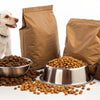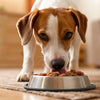Are Dogs Supposed to Chew Kibble? Understanding Your Dog's Eating Habits
- Houndsy
Table of Contents
- Introduction
- The Evolutionary Perspective: Why Do Dogs Eat Differently?
- Are Dogs Supposed to Chew Kibble?
- The Importance of Chewing for Dogs
- Tips for Encouraging Chewing Behavior
- What to Watch For: Signs of Eating Problems
- Conclusion
- FAQs
Introduction
Did you know that nearly 60% of dog owners worry about their pets' eating habits? If you're one of them, you might have asked yourself, "Are dogs supposed to chew kibble?" This question touches on an important aspect of pet ownership that affects your dog's overall health and well-being. As pet lovers, we all want to ensure that our furry companions are not just fed but are thriving in every aspect of their lives.
In this blog post, we will explore the intricacies of how dogs eat, the importance of chewing, and what it means for their health. We’ll discuss the evolutionary perspectives behind your dog’s eating habits, the potential risks of not chewing, and practical tips for encouraging better chewing behavior. By the end of this article, you should have a comprehensive understanding of your dog’s feeding behaviors and how to enhance their mealtime experience.
We invite you to reflect on your own pet’s eating habits as we delve into this topic. Are they gulping down their kibble without a second thought, or do they take their time to savor each bite? Understanding these behaviors can help you make informed decisions about your dog's diet and feeding routine.
So, let's dive in and uncover whether dogs are supposed to chew kibble, what it means for their health, and how we can improve their feeding experience.
The Evolutionary Perspective: Why Do Dogs Eat Differently?
To understand whether dogs are supposed to chew kibble, we first need to look at their evolutionary background. Dogs are descendants of wolves, and their eating behaviors are deeply rooted in survival instincts. In the wild, dogs had to consume their food quickly to avoid competition from other animals. This instinctual gulping behavior is still prevalent in many domesticated dogs today.
Instinctual Gulping
This innate behavior, often referred to as instinctual gulping, stems from the urgency with which wild canines needed to eat. They had to secure their food before it was taken by others. While our modern dogs are no longer facing such threats, the instinct to eat quickly remains.
The Role of Teeth
Interestingly, dogs' teeth are designed more for tearing and shearing than for chewing. They possess sharp canines and premolars that help them break down food into smaller pieces, but they lack the flat molars that humans have for grinding food. This anatomical design supports a more rapid consumption of food, making it easier for dogs to swallow kibble whole.
Are Dogs Supposed to Chew Kibble?
The straightforward answer to the question, "Are dogs supposed to chew kibble?" is both yes and no. While dogs can chew their kibble, they don't necessarily have to in the same way humans do. Here are some key points to consider:
Not All Dogs Chew
Some dogs will chew their kibble while others will swallow it whole. This can depend on various factors, including the dog's breed, age, and even their personality. For example, larger breeds may tend to gulp their food due to their size and instinct.
Nutritional Considerations
Despite their chewing habits, it is essential that dogs still consume a balanced diet. Kibble is designed to provide all the necessary nutrients in a convenient form. However, if a dog is not chewing, they may miss out on some of the benefits of their food.
Potential Risks of Not Chewing
While it may not be necessary for dogs to chew their kibble thoroughly, there are risks associated with not chewing at all. Rapid consumption can lead to several health issues, including:
- Choking Hazard: Swallowing large pieces of kibble can pose a choking risk, especially for smaller breeds.
- Bloat: Eating too quickly can lead to gastric dilatation-volvulus (GDV), a life-threatening condition that causes the stomach to fill with gas and twist.
- Digestive Issues: Gulping food can result in indigestion, upset stomach, and even vomiting.
The Importance of Chewing for Dogs
Chewing plays a critical role in a dog’s health, even if it’s not as essential as it is for humans. Here are some reasons why encouraging your dog to chew is beneficial:
Improved Digestion
When dogs chew their food, they break it down into smaller pieces, making it easier for their digestive system to process. Chewing stimulates saliva production, which contains enzymes that aid in digestion.
Dental Health
Chewing kibble can also have a positive impact on dental health. The mechanical action of chewing helps reduce plaque and tartar buildup, promoting healthier gums and teeth. This is particularly relevant for dogs that may be prone to dental issues.
Mental Stimulation
Encouraging your dog to chew can provide mental stimulation. It can turn mealtime into an engaging activity, preventing boredom and destructive behaviors that may arise from a lack of stimulation.
Tips for Encouraging Chewing Behavior
If your dog tends to gulp their kibble instead of chewing it, there are several strategies you can implement to encourage a more deliberate eating pace.
1. Choose the Right Kibble
Selecting kibble that is appropriately sized for your dog can make a difference. Larger kibble pieces may encourage chewing, while smaller pieces can be swallowed more easily. Consider trying different shapes and sizes until you find the right fit.
2. Use Slow Feeder Bowls
Slow feeder bowls are designed with obstacles that require dogs to work for their food. These bowls encourage dogs to take smaller bites and chew their food, promoting better digestion and reducing the risk of choking.
3. Add Water or Broth to Kibble
Soaking kibble in warm water or broth can soften it, making it easier for your dog to chew. This can also enhance the flavor, making mealtime more appealing.
4. Establish a Calm Feeding Environment
Creating a calm and peaceful environment during mealtime can help reduce anxiety and encourage your dog to eat slowly. Avoid distractions and consider separating pets during feeding times if you have multiple dogs.
5. Implement Positive Reinforcement Training
Training your dog to chew can be a rewarding experience for both of you. Use commands like "chew" or "slow down" during mealtime, and reward your dog with praise or treats when they exhibit the desired behavior.
What to Watch For: Signs of Eating Problems
Monitoring your dog's eating habits is crucial for identifying potential health issues. Here are some signs that may indicate a need for veterinary attention:
- Sudden Change in Eating Habits: If your dog suddenly stops chewing or begins to gulp their food, it may signal an underlying health issue.
- Dental Issues: Bad breath, swollen gums, or discolored teeth can indicate dental problems that make chewing painful.
- Vomiting or Regurgitation: Frequent vomiting or regurgitation after meals can be a sign that your dog is eating too quickly.
- Weight Changes: If your dog is gaining or losing weight unexpectedly, it may be related to their eating habits.
Conclusion
Understanding whether dogs are supposed to chew kibble involves considering their evolutionary background, anatomical design, and individual feeding habits. While dogs may not need to chew their kibble as thoroughly as we do, encouraging them to do so can significantly enhance their health and well-being.
At Houndsy, we believe in the importance of making mealtime a positive experience for our furry friends. Our flagship product, the Houndsy Kibble Dispenser, is designed to make feeding more convenient, consistent, and beautiful. With its mid-century modern design, large storage capacity, and auto-locking mechanism, the Houndsy Kibble Dispenser ensures your pup gets perfectly portioned meals every time while reducing the mess.
As pet parents, we have the responsibility to provide our dogs with not only nutritious food but also a fulfilling feeding experience. By implementing the tips discussed in this article, you can help your dog enjoy their meals, promote better digestion, and maintain optimal dental health.
FAQs
1. Is it normal for my dog to not chew their food?
Yes, it can be considered normal for dogs to skip chewing due to their instinctual behaviors. However, if you notice a sudden change in their eating habits, it may indicate a health issue.
2. When is not chewing food a problem for dogs?
Not chewing can be problematic if it leads to choking, bloat, or digestive issues. If your dog used to chew and suddenly starts gulping, it's important to consult a veterinarian.
3. How do I get my dog to chew his food?
You can encourage chewing by choosing the right kibble, using slow feeder bowls, adding water or broth to their food, creating a calm feeding environment, and implementing positive reinforcement training.
By focusing on these aspects, we can not only ensure our dogs are well-fed but also well-cared for in their daily lives. Let's make every meal count!












